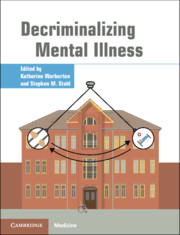Book contents
- Decriminalizing Mental Illness
- Decriminalizing Mental Illness
- Copyright page
- Contents
- Contributors
- Part I Introduction/Description of the Problem
- Part II Solutions
- Part III Psychopharmacological Treatment Considerations
- Part IV Nonpsychopharmacological Treatment Considerations
- Chapter 21 Neurocognition and Social Cognition Training as Treatments for Violence and Aggression in People with Severe Mental Illness
- Chapter 22 Examining Violence Among Not Guilty by Reason of Insanity State Hospital Inpatients Across Multiple Time Points: The Roles of Criminogenic Risk Factors and Psychiatric Symptoms
- Chapter 23 Criminogenic Risk and Mental Health: A Complicated Relationship
- Chapter 24 Implementation of a Specialized Treatment Program to Reduce Violence in a Forensic Population
- Chapter 25 From Trauma-Blind to Trauma-Informed: Rethinking Criminalization and the Role of Trauma in Persons with Serious Mental Illness
- Chapter 26 The Indistinguishables: Determining Appropriate Environments for Justice-Involved Individuals
- Chapter 27 Breaking Down Long-Term Chronic Aggression Within a Forensic Hospital System
- Part V Criminal Justice and Social Considerations
- Index
- References
Chapter 24 - Implementation of a Specialized Treatment Program to Reduce Violence in a Forensic Population
from Part IV - Nonpsychopharmacological Treatment Considerations
Published online by Cambridge University Press: 19 October 2021
- Decriminalizing Mental Illness
- Decriminalizing Mental Illness
- Copyright page
- Contents
- Contributors
- Part I Introduction/Description of the Problem
- Part II Solutions
- Part III Psychopharmacological Treatment Considerations
- Part IV Nonpsychopharmacological Treatment Considerations
- Chapter 21 Neurocognition and Social Cognition Training as Treatments for Violence and Aggression in People with Severe Mental Illness
- Chapter 22 Examining Violence Among Not Guilty by Reason of Insanity State Hospital Inpatients Across Multiple Time Points: The Roles of Criminogenic Risk Factors and Psychiatric Symptoms
- Chapter 23 Criminogenic Risk and Mental Health: A Complicated Relationship
- Chapter 24 Implementation of a Specialized Treatment Program to Reduce Violence in a Forensic Population
- Chapter 25 From Trauma-Blind to Trauma-Informed: Rethinking Criminalization and the Role of Trauma in Persons with Serious Mental Illness
- Chapter 26 The Indistinguishables: Determining Appropriate Environments for Justice-Involved Individuals
- Chapter 27 Breaking Down Long-Term Chronic Aggression Within a Forensic Hospital System
- Part V Criminal Justice and Social Considerations
- Index
- References
Summary
The California Department of State Hospitals (DSH) manages the psychiatric care of almost 7,000 patients admitted to any of its five hospitals. Over 90% of these patients have forensic commitments, meaning they have been charged with, or convicted of, a crime. Treating patients with mental illness and criminal behavior reflects a general trend within state psychiatric facilities.An increase in physical violence towards staff and patients has been attributed to this mandate to care for patients with both severe mental illness and criminal backgrounds. Addressing violence is a pressing need within state hospital systems, as a safe treatment environment is quintessential to the delivery of effective care.
- Type
- Chapter
- Information
- Decriminalizing Mental Illness , pp. 251 - 257Publisher: Cambridge University PressPrint publication year: 2021

